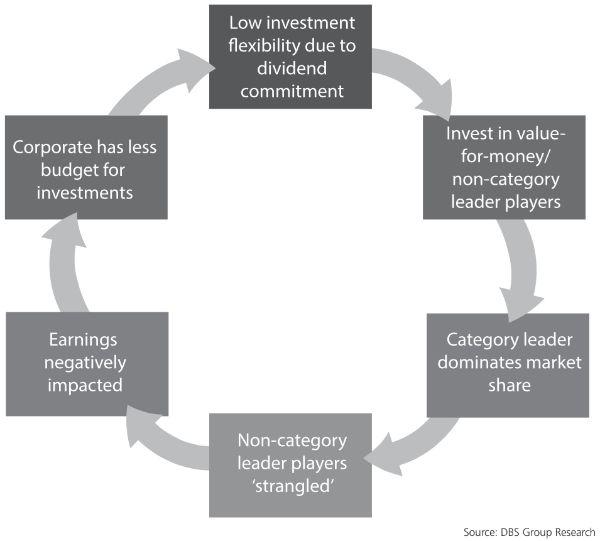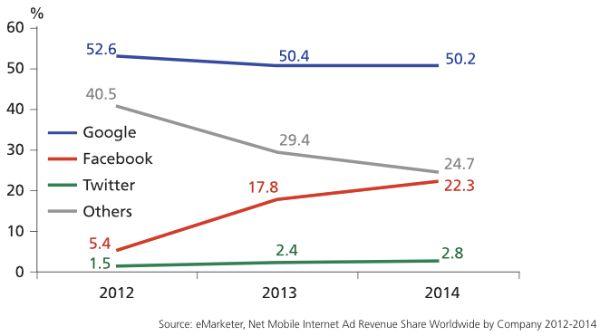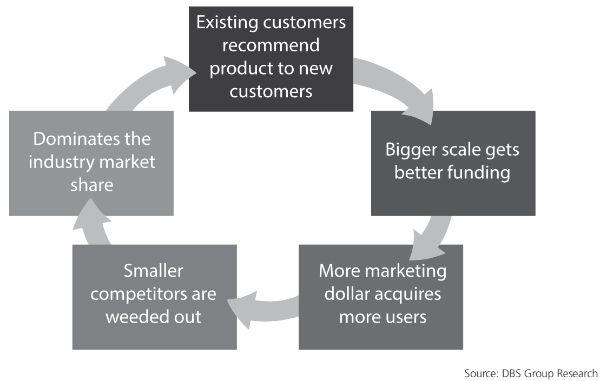Paradigm Shifts: Old versus New
It’s time firms leave the vicious cycle and start to invest in category leaders with higher growth potential.

Vicious Cycle of Investing in Value-for-Money Players

Diagram 1: Vicious cycle for corporates
The traditional corporate mindset regards value-for-money investments as wiser and making more financial sense than paying top valuation for a market leader. There is nothing wrong with this strategy, especially since the duty of most listed firms is to ensure that investments and acquisitions are accretive for shareholders and dividend payouts are maintained.
However, dividend commitments restrict corporates and leave them with limited flexibility to buy potential acquisitions that can complement and grow the business well. This can become a vicious cycle.
Here is a scenario based on some real examples. A big telecommunications company buys a small mobile advertising start-up with hopes that this acquisition will boost its digital business. But it doesn’t work out that way. Although promising, the start-up cannot dent the dominance of Facebook and Google in the mobile advertising space. And so, the acquisition is a flop. According to eMarketer 2012-2014 data, only Facebook has really been successful in gaining mobile ad-revenue market share. In this situation, many small players are strangled and their big corporate investors are left with losses.

Diagram 2: Mega names Google, FaceBook and Twitter squeezing small players in net mobile internet ad revenue to gain market share
This brings us to the new school of thought. It maintains that to play the game, investors must not be afraid to pay high prices for category winners with high growth rates. SoftBank Corp., a Japanese telecommunications and Internet corporation, advocates this mentality and actively invests in many top winners of each category across the globe. Look at Softbank’s investment in Chinese e-commerce giant Alibaba Group Holdings and you know that its strategy has paid off handsomely. Based on last November’s performance, Softbank reaped a return of 4,350 times on the initial US$20 million investment it made in Alibaba in 2000.
“Investors must not be afraid to pay high prices for category winners with high growth rates”
Last December, Softbank invested S$250 million in the taxi service aggregator app, GrabTaxi. The deal was Softbank’s biggest investment in a Southeast Asian firm. And, it embodies Softbank’s strategy of investing in category leaders within markets with immense growth potential. Over the past year, the number of Grabtaxi users has jumped six-fold to about half a million. And, the taxi drivers in its network have grown four-fold to 60,000. Now backed by Softbank, Grabtaxi is in a stronger position to battle the bigger global player, Uber.
Softbank has also paid high valuation for top players such as Snapdeal, an Indian online retailing marketplace (for US$627 million), and India’s Uber equivalent, OlaCabs (for US$210 million).
On a side note, Softbank pays out less than 10% of its earnings to its shareholders and uses most of the rest to acquire category-leading start-ups so as to build up the long-term business. That contrasts with the behaviour of many big traditional corporates which distribute most of their earnings as dividends, thus limiting the scope of their strategic investment strategies.
Virtuous Cycle of the Network Effect
The way to become a digital monopoly is to be the first to market a product that fits the needs of the consumers. Being first allows one to enjoy the full network effect. It is an essential building block. But it must also be matched with financial muscle to support the venture. In essence, the strategy of investing in market leaders creates a virtuous cycle. A first-in-market start-up and a big investor need each other to dominate the digital space.
All in all, it makes perfect business sense for investors to pay top dollar to invest in category leaders in markets with high growth potential.

Diagram 3: Virtuous cycle for top start-ups
Report produced by: Asian Insights Office, DBS Group Research
Was this information useful?
Thanks for your feedback
Subscribe to DBS BusinessClass
Stay updated with the latest market trends and industry insights, connect with a network of entrepreneurs, and gain access to exclusive event invitations. Join Asia's fastest growing business community – get your complimentary membership here.





That's great to hear. Anything you'd like to add?
We're sorry to hear that. How can we do better?